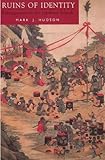Ruins of Identity : Ethnogenesis in the Japanese Islands / Mark James Hudson.
Material type: TextPublisher: Honolulu : University of Hawaii Press, [1999]Copyright date: ©1999Description: 1 online resource (336 p.)Content type:
TextPublisher: Honolulu : University of Hawaii Press, [1999]Copyright date: ©1999Description: 1 online resource (336 p.)Content type: - 9780824864194
- 952 21
- DS830 .H83 1999eb
- online - DeGruyter
| Item type | Current library | Call number | URL | Status | Notes | Barcode | |
|---|---|---|---|---|---|---|---|
 eBook
eBook
|
Biblioteca "Angelicum" Pont. Univ. S.Tommaso d'Aquino Nuvola online | online - DeGruyter (Browse shelf(Opens below)) | Online access | Not for loan (Accesso limitato) | Accesso per gli utenti autorizzati / Access for authorized users | (dgr)9780824864194 |
Browsing Biblioteca "Angelicum" Pont. Univ. S.Tommaso d'Aquino shelves, Shelving location: Nuvola online Close shelf browser (Hides shelf browser)

|

|

|

|

|

|

|
||
| online - DeGruyter Remaking the Chinese City : Modernity and National Identity, 1900-1950 / | online - DeGruyter Riven by Lust : Incest and Schism in Indian Buddhist Legend and Historiography / | online - DeGruyter Routes and Roots : Navigating Caribbean and Pacific Island Literatures / | online - DeGruyter Ruins of Identity : Ethnogenesis in the Japanese Islands / | online - DeGruyter Ryōgen and Mount Hiei : Japanese Tendai in the Tenth Century / | online - DeGruyter Sacred Biography in the Buddhist Traditions of South and Southeast Asia / | online - DeGruyter Sacred Texts and Buried Treasures : Issues in the Historical Archaeology of Ancient Japan / |
Frontmatter -- Contents -- Preface -- 1. Introduction -- Part I. Japanese Ethnicity: Histories of a Concept -- 2. Tales Told in a Dream -- Part II. The Yayoi and the Formation of the Japanese -- 3. Biological Anthropology and the Dual-Structure Hypothesis -- 4. The Linguistic Archaeology of the Japanese Islands -- 5. From Jōmon to Yayoi: The Archaeology of the First Japanese -- 6. An Emerging Synthesis? -- Part III. Post-Yayoi Interaction and Ethnogenesis -- 7. Ethnicity and the Ancient State -- 8. The Unbroken Forest? -- 9. Japanese Ethnicity Some Final Thoughts -- Postscript -- Notes -- Bibliography
restricted access online access with authorization star
http://purl.org/coar/access_right/c_16ec
Many Japanese people consider themselves to be part of an essentially unchanging and isolated ethnic unit in which the biological, linguistic, and cultural aspects of Japanese identity overlap almost completely with each other. In its examination of the processes of ethnogenesis (the formation of ethnic groups) in the Japanese Islands, Ruins of Identity offers an approach to ethnicity that differs fundamentally from that found in most Japanese scholarship and popular discourse. Following an extensive discussion of previous theories on the formation of Japanese language, race, and culture and the nationalistic ideologies that have affected research in these topics, Mark Hudson presents a model of a core Japanese population based on the dual origin hypothesis currently favored by physical anthropologists. According to this model, the Jomon population, which was present in Japan by at least the end of the Pleistocene, was followed by agriculturalists from the Korean peninsula during the Yayoi period (ca. 400 BC to AD 300). Hudson analyzes further evidence of migrations and agricultural colonization in an impressive summary of recent cranial, dental, and genetic studies and in a careful examination of the linguistic and archaeological records. The final sections of the book explore the cultural construction of Japanese ethnicity. Cultural aspects of ethnicity do not emerge pristine and fully formed but are the result of cumulative negotiation. Ethnic identity is continually recreated through interaction within and without the society concerned. Such a view necessitates an approach to culture change that takes into account complex interactions with a larger system. Accordingly, Hudson considers post-Yayoi ethnogenesis in Japan within the East Asian world system, examining the role of interaction between core and periphery in the formation of new ethnic identities, such as the Ainu. He argues that the defining elements of the Ainu period and culture (ca. AD 1200) can be linked directly to a dramatic expansion in Japanese trade goods flowing north as Hokkaido became increasingly exploited by core regions to the south. Highly original and at times controversial, Ruins of Identity will be essential reading for students and scholars in Japanese studies and will be of interest to anthropologists and historians working on ethnicity in other parts of the world.Text adopted at University ofChicago
Mode of access: Internet via World Wide Web.
In English.
Description based on online resource; title from PDF title page (publisher's Web site, viewed 02. Mrz 2022)


